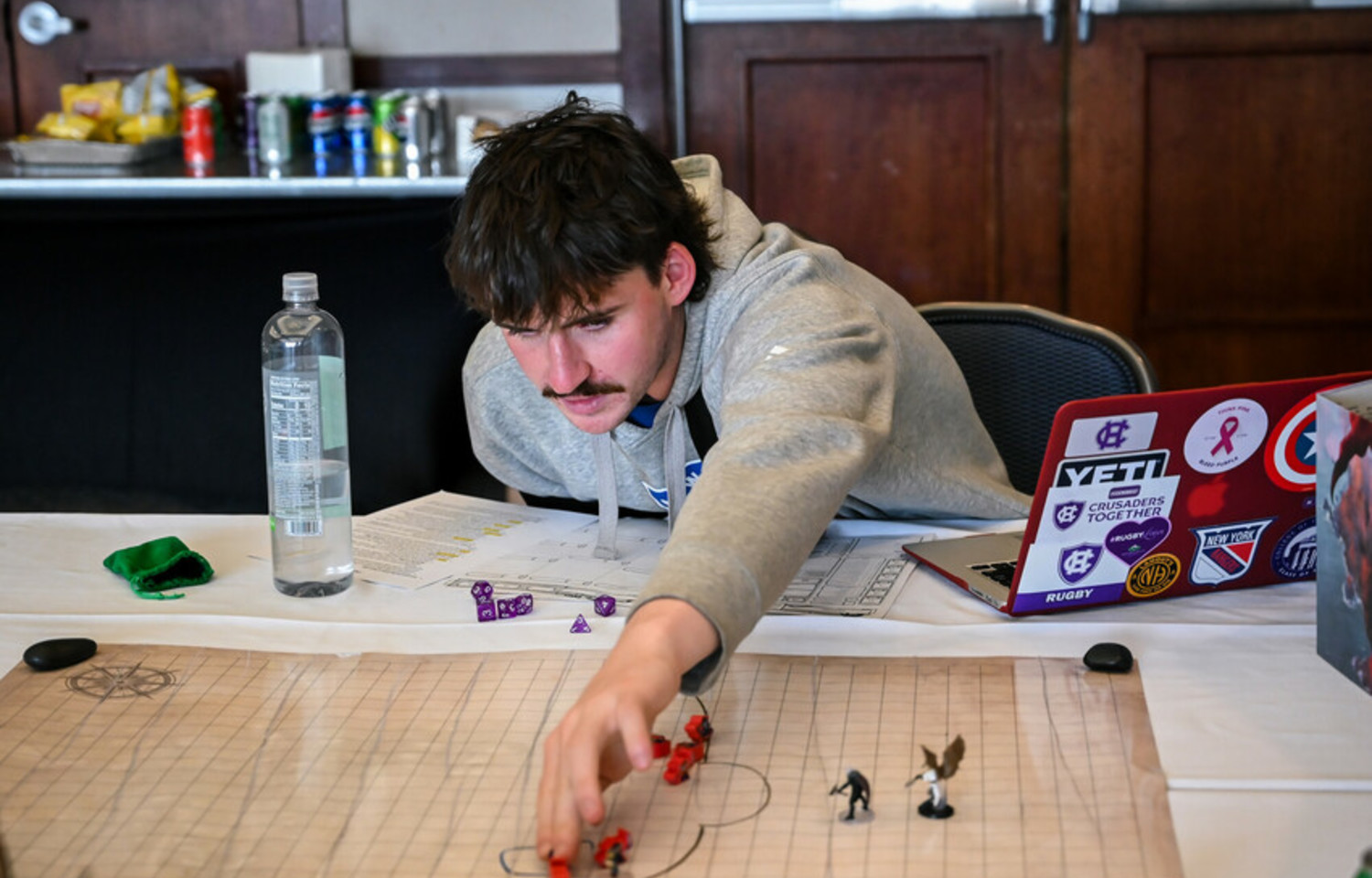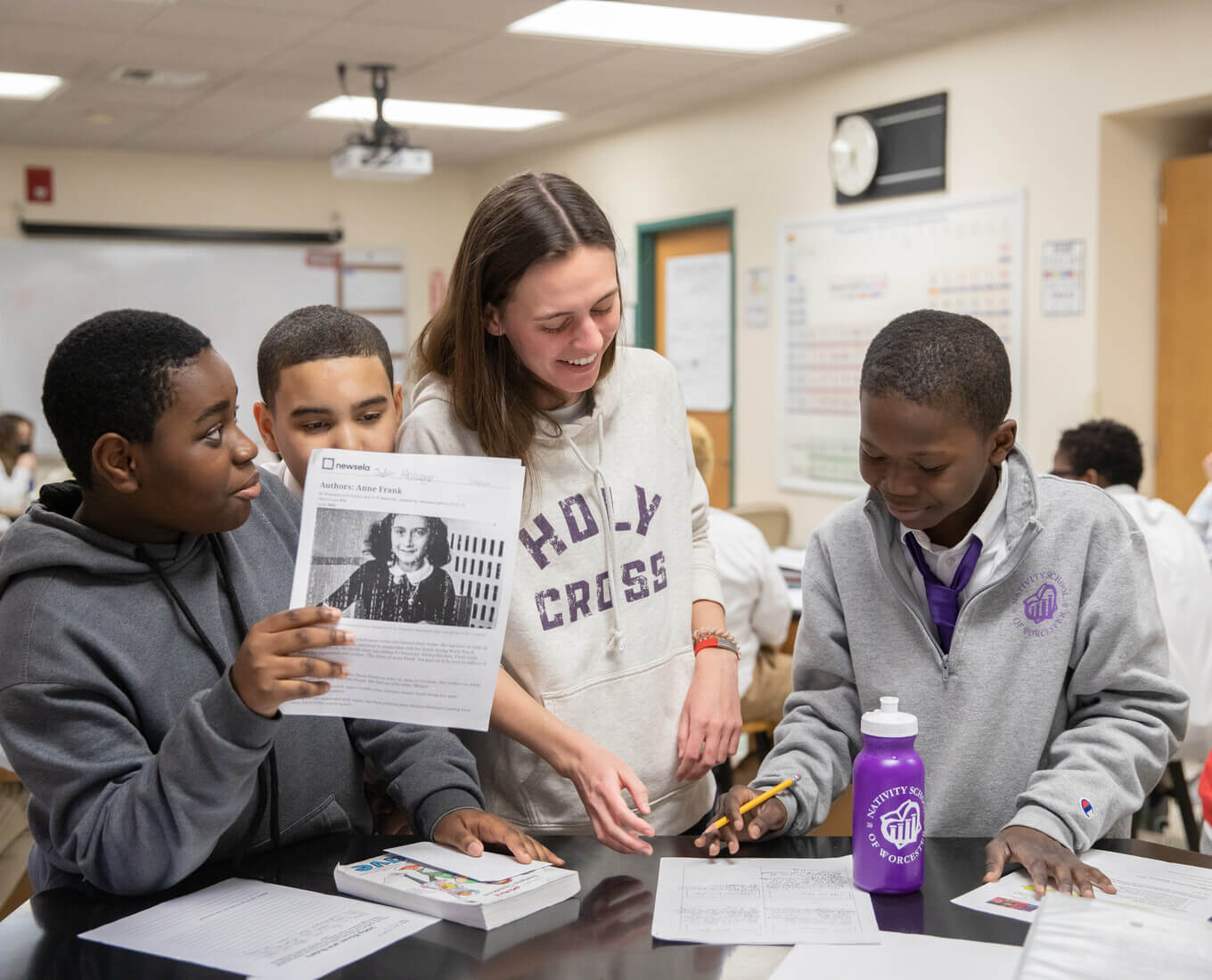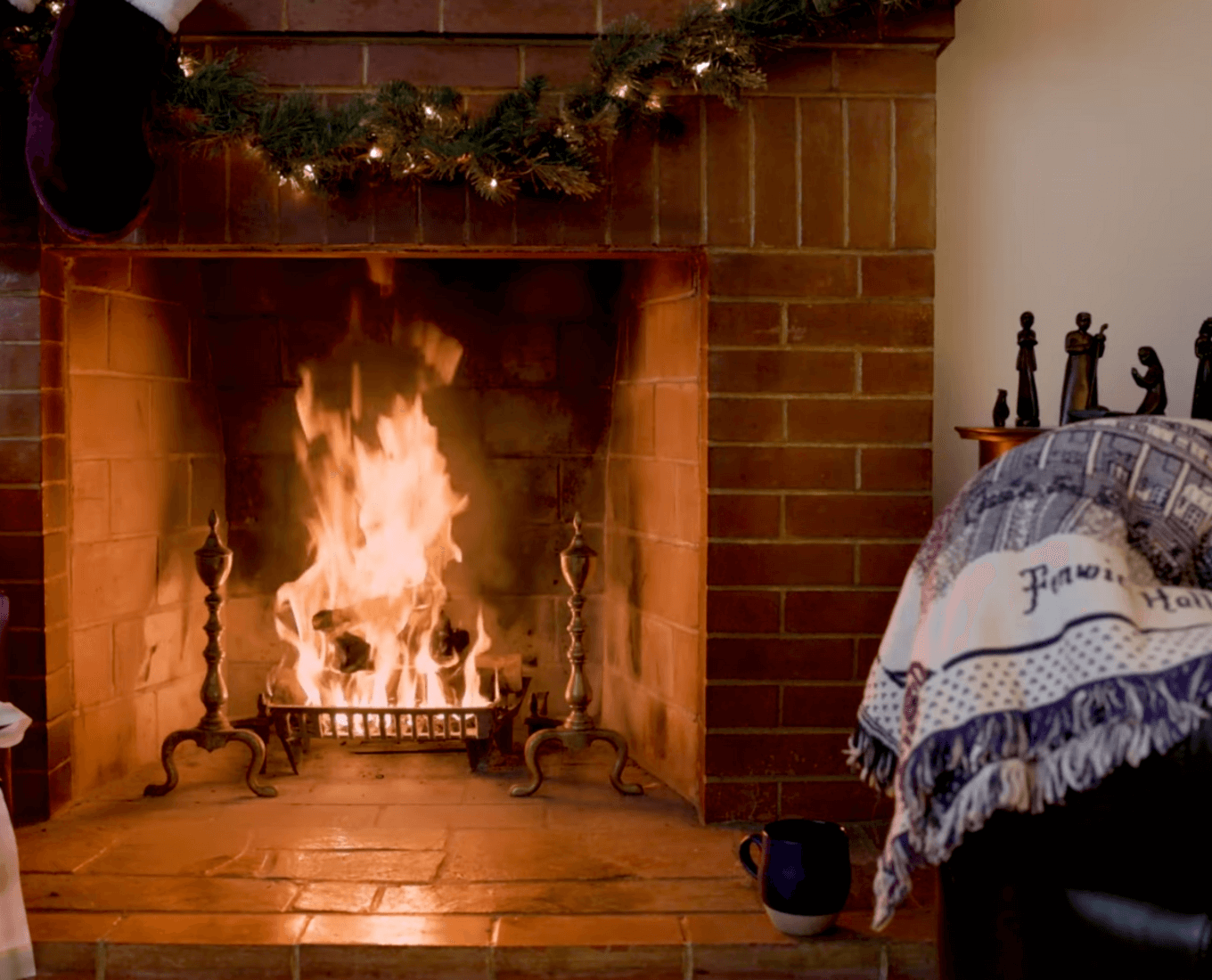Dungeons & Dragons, in a college classroom? Jorge Santos, associate professor of English, was skeptical. But Jorge Santos, dungeon master, was intrigued.
The classic fantasy role-playing game Dungeons & Dragons (D&D) was created in 1974 and according to publisher Hasbro, more than 50 million people around the world have “interacted” with D&D since then.
Players improvise a story together as they embark on fantastical quests guided by their head narrator, known as the dungeon master. They cast spells, hunt for treasure and face terrifying monsters, rolling dice to learn their fate. With no conventional winning or losing, games can continue indefinitely.
D&D has been part of Santos’ story since he was a 1990s Texas teenager. His parents warned him against playing amid a national “satanic panic” that arose in the 1980s, claiming the game encouraged demonism. Joining his friends at the D&D table started as a mild teen rebellion, Santos said: “I went in with a morbid curiosity, but it turned out it was just a wholesome team-building game with a bunch of nerds!” And he loved it.
Later, through college, graduate school, professorship and a pandemic, D&D has helped Santos find and sustain community.
But did D&D have a place in his college classroom?
ORIGIN STORY
In May 2023, Santos and fellow Holy Cross professors co-founded the College’s new Critical Race and Ethnic Studies program, and Santos began exploring course design for the new program.
“The challenge I see when we have discussions about race and ethnicity is that we talk about injustices and traumas of the past, as we should, but we tend to stop there. We have to have that next conversation. I'm trying to return to a level of empathy and understanding,” Santos said. “And tabletop role-playing games (TTRPG), like Dungeons & Dragons, allow us to pretend we're a different identity.”
When he heard that Jarred Wiehe, his close friend and a colleague at Texas A&M University-Corpus Christi, was successfully using TTRPGs in the classroom to discuss gender performativity, Santos wondered: Was there a way to use D&D to have deeper conversations about race and ethnicity?
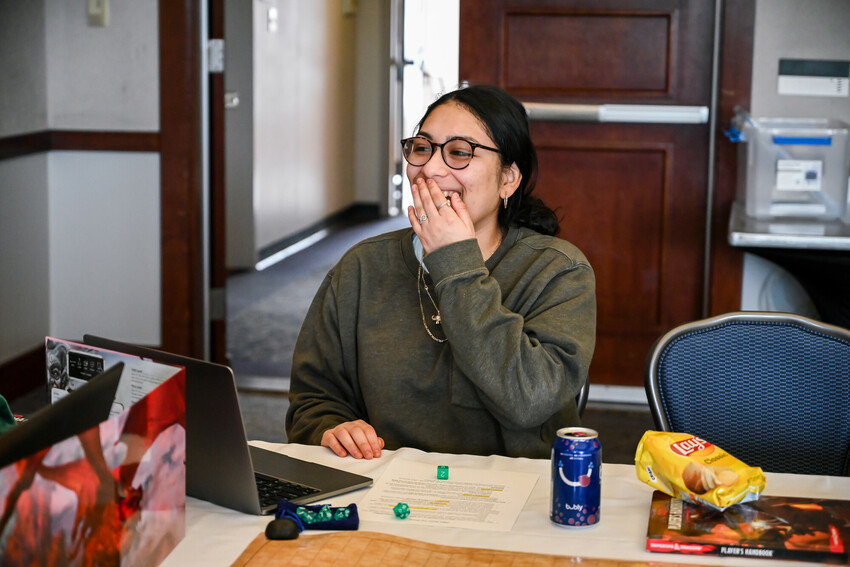
Weiss Summer Research student Jango Janigian ’25 thought so.
Janigian asked Santos to advise their 2023 research project on folklore and racial narratives within D&D. They focused their research on “Journeys through the Radiant Citadel,” a hugely popular book of 13 playable D&D short stories, each written by a different author of color who includes folklore, mythology and history from their own world cultures and lived experiences.
“D&D is a rich vehicle to talk about diversity because, at their core, TTRPGs are systems of empathy,” Janigian said. “They allow players to experience the lives (and research) of others in a low-stakes and fun environment, offering the opportunity to explore cultures that are removed from them temporally, geographically or academically. D&D also gives voices to the marginalized and historically underrepresented — allowing people to adapt and explore their culture through their characters.”
Noted Santos: “When I saw Jango’s project, I knew I wanted to create a course designed to make students produce the work that Jango just produced.” Jorge Santos, the academic, was now convinced D&D had a place in his classroom.
“The promise of literature has always been to see the world through someone else's eyes,” he said. “If we take that to the next level, D&D asks you to be that person and tell the story yourself.”
A COURSE ON A QUEST
It is a Friday afternoon in March in Santos’ Dungeons, Dragons, & Diversity classroom, and wizards, rangers, bards and monks have replaced his first-year Montserrat students.
Grouped into three teams, players grip small velvet pouches containing dice. Dungeon Master Santos commands the room in a floor-length black robe (worn, on another occasion, for pomp and circumstance) as mystical music plays from his laptop. He decrees today’s quest: Locate and capture four potions hidden across campus.
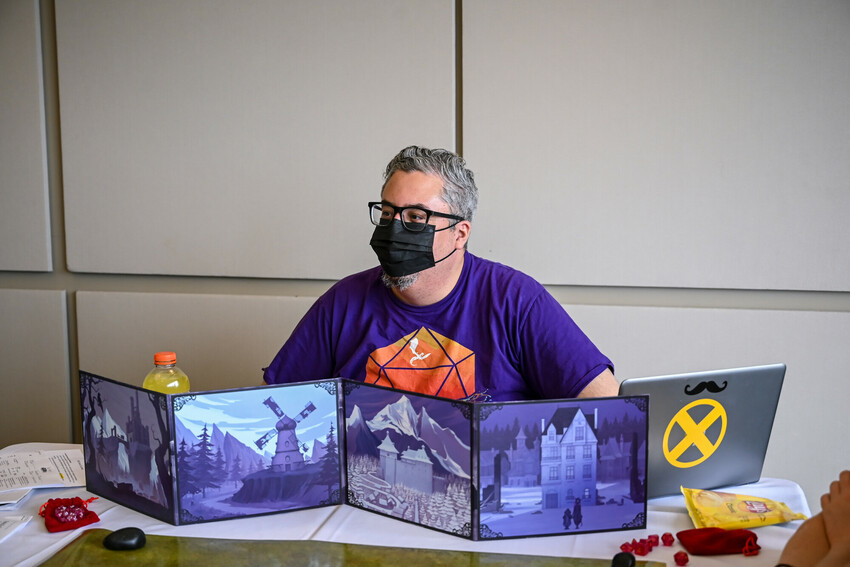
Today, each student is playing as a D&D character version of themselves, drawing on their unique skills and abilities as they cause distractions, solve puzzles and work together. Santos narrates how each move unfolds. As the minutes tick down and the first three potions are pocketed, all three teams virtually descend on Brooks Hall (where, as first-year Montserrat students, they all live together), as they battle for the final potion.
“To every student's credit, all of them are committed to the project of the class,” Santos said. “They understand D&D is a vehicle, it's not the point.”
It’s the first time students are playing the game in class; only four have prior experience playing it. However, most have some familiarity thanks to D&D’s resurgence into the cultural forefront with the popularity of TV show “Stranger Things,” D&D Web series “Critical Role” and even D&D TikTok.
Students spent the two-semester course examining racial commentary in 21st-century fantasy films and classic novels, covering superheroes, allegorical sci-fi, dystopian fiction and supernatural horror in the fall, before turning their attention second semester to high fantasy and D&D to discuss positive and negative representations of ethnicity and race.
D&D AND REPRESENTATION
“D&D has a mixed bag history of racial representations — lots of wins and lots of embarrassing losses,” Santos said.
One of those issues was most evident in past iterations of D&D characters. A D&D player builds their hero by filling out a character sheet where they select a “species” — previously referred to in D&D as “race” until an official change in 2022 — like human, elf or orc.
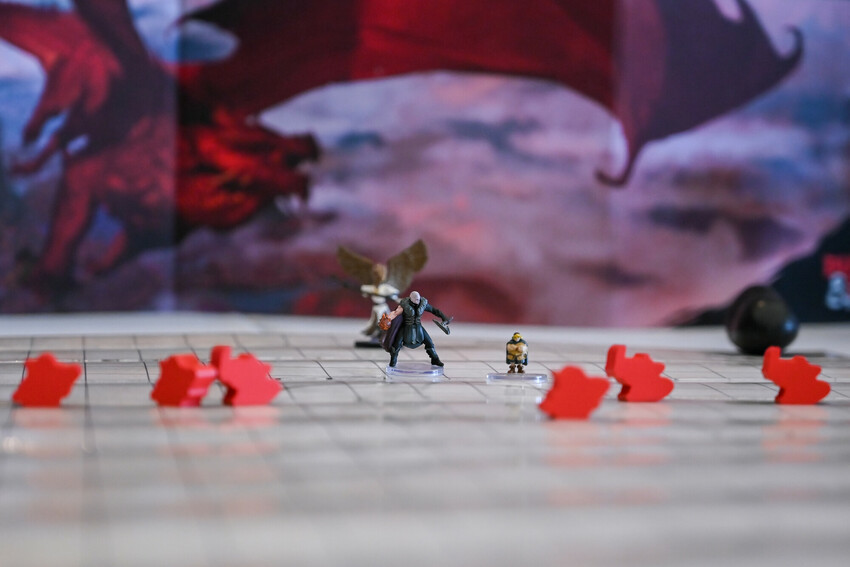
Over the years, players often incorporated elements from their favorite authors, most notably fantasy writer J. R. R. Tolkien. “High fantasy is always a blend of cultural knowledge with contemporary circumstances,” Santos noted.
While Tolkien, who predominantly wrote in the first half of the twentieth century, is widely considered anti-racist, Santos notes, problematic discourse of his time still crept into his work, including the linking of racial identities to inborn characteristics. For example, Tolkien’s elves, based on ancient European mythology, are benevolent and wise. In contrast, Tolkien’s orcs, often painted as the non-European “other,” are evil and monstrous. These depictions got inherited and gamified in D&D, Santos said.
In a 2020 blog post, D&D developers said these descriptions were “painfully reminiscent of how real-world ethnic groups have been and continue to be denigrated” and vowed, among other changes, to depict orcs “just as morally and culturally complex as other peoples” moving forward. “‘Human’ in D&D means everyone, not just fantasy versions of northern Europeans, and the D&D community is now more diverse than it’s ever been,” the developers wrote.
The 2022 publication of “Journeys Through the Radiant Citadel,” the text Janigian studied for their summer research project, is considered a “win” in the game’s history of representation, Santos said.
Using Janigian’s project as the model, Santos’ students researched the mythological, folkloric, and sociopolitical aspects of one of the 13 short stories from the book. Then, they designed characters to play from that story’s world culture, and one different than their own.
“The culminating project of the course is for students to pretend and embody for a whole afternoon that they are a member of another culture in a fantasy setting — and to do it responsibly,” Santos said. “Instead of absorbing the story, they're telling it and writing it. There is a way to do this that's celebratory and enlightening, and is more than just a terrible Halloween costume.”
THE FINAL ADVENTURE
On a Sunday in late April, Santos gathered his 14 Montserrat students in a large suite in the Hogan Campus Center. They finally had the chance to play as the character they had exhaustively researched and designed, inspired by a story from the “Radiant Citadel.” Santos and three members of Holy Cross’ TTRPG club, “Session Zero,” served as dungeon masters.
Player: Nik Karvelas ’27 | Character: Tequihua — dwarf, barbarian
Story: “Trail of Destruction” by Alastor Guzman | Drawn from: Aztec culture and Mexico City natural disasters
“Tequihua is strong and loyal, almost to a fault,” Karvelas explained. “His natural inclination to take care of family, a widespread philosophy across his native region of Tletepec, has forced him to take care of his uncaring father all his life. He desires to adventure on his own while battling his obligation to his father.
“One thing the experience taught me about my selected region is the focus on human perseverance and compassion. The author of my section took inspiration from the 2017 Mexico earthquake to shape the main conflict in an almost tragic way. The author was also inspired by the acts of kindness shown by survivors and others trying to help each other after the wake of destruction.
“Playing a character with this type of mindset changed the way I took actions during our adventure. I always tried to help my teammates instead of going for hits on an enemy myself. I tried to support poor non-player characters who needed help and tried to do the kind thing whenever possible. I was shocked by how much I took from the experience.”
Player: Avery Nientimp ’27 | Character: Modesta Bahaghari — human, ranger and folk hero
Story: “Between Tangled Roots” by Pam Punzalan | Drawn from: Filipino culture and mythology
“Modesta holds high value in the recognition and feelings of those around her,” Nientimp said. “Professor Santos also shared that some players incorporate their own vices into characters to learn how to navigate them. I found this point extremely intriguing and sought to deepen my understanding of how my stubbornness could be used constructively with Modesta’s strengths.
“After reading and researching the adventure, its story embodied strong tones of ‘seeking the whole picture’ and restraining from judgment until doing so. While playing as Modesta, the majority of my actions involved the protection of my party members, animal companion, and those caught in the line of danger. However, I remained curious and open-minded about why the so-called ‘threats’ throughout the game were retaliating (specifically what ill had been imposed on them to seek vengeance).
“The most memorable experience of the day was definitely connecting the ethics of the Philippines' culture with problem-solving and strategy throughout the game. I asked the DM profusely, ‘What good will this action do?’ especially when my character had to engage in battle. I felt very connected to the material I researched during and after the session.”
Player: Patrick Bohn ’27 | Character: Iraj Pasdar — human, war cleric
Story: “Shadow of the Sun” by Justice Ramin Arman | Drawn from: Persian culture and mythology
“Iraj is a deeply untrusting individual as his family was killed in cold blood and he blames himself for their death,” Bohn said. “He is also often put in the balance between what is best and what is right.
“At first, I did not see the connection between my character and the culture he was from, but as the story progressed, I realized that I was doing things that I would not do. It was interesting to think about how Iraj would work as a magical character in the context of Persian mythology and how that plays into his spellcasting ability.
“The most memorable moment was when our dungeon master mixed Iraj’s family into the story. I felt an actual connection to these people, and it was also cool to see how a DM can adjust the story based on the characters.”
Player: Jorge Santos | Role: Dungeon Master
“The students let themselves get absorbed by the experience,” Santos said. “What impressed me most was how they treated the NPCs — non-player characters, or characters that populate their fictional settings played by the DM.
“They understood they were guests in foreign lands and tried their best not to battle their way to every solution (a notorious problem for beginners) and tried to solve problems ethically.”
FOUND FAMILY
The course has been a perfect fit for Montserrat, largely because the first-year program is all about building community, something D&D does well, Santos said. “We even have a two-week unit on the most traditional D&D narrative — the ‘found family’ story. We are embracing that because we are a found family in this class. The one thing that ties all D&D players together is a thirst for community; that is universal.”
Karvelas reflects, “The more I think about it, the more I realize that D&D is quite literally a Montserrat course, but in a game form. We've all become closer people through playing a game; it’s not only about generating fun but also about understanding each other.”
“It's been nice to have this safe environment where we can talk about serious, societal issues and get used to the kinds of conversations we’re going to have at a school like Holy Cross,” Bohn said. “The most important part of the class is that you come in and try to put yourself in somebody else's shoes.”
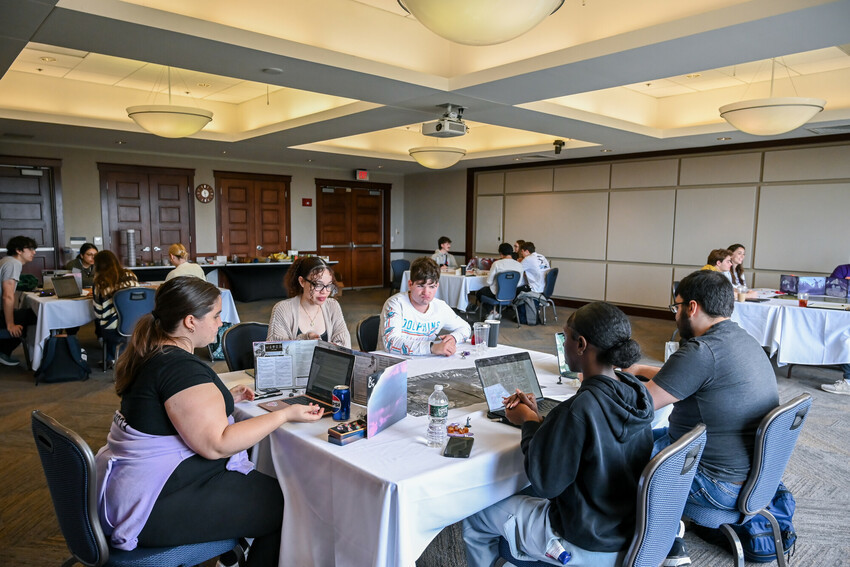
“Professor Santos has done an amazing job getting us to help each other be creative and support each other,” Nientimp shares. “The course is an incredible opportunity to dig into what makes you unique, all while spreading your wings and dipping your toes into different cultures.”
Students in the course create posters for the Academic Conference on their research, record a podcast about their experience and write a research paper as well as reflective pieces. “If I see an assignment that's becoming popular at the College, I work it in so students have seen it once already,” Santos said.
“The mission of Montserrat is very much to prepare students for their lives at Holy Cross,” Santos said. “I treat Montserrat like a tutorial level in a video game. I’m going to teach you how the game works, and I won't let you move on until you accomplish the task. I tell my students I don't throw curveballs, I throw fastballs. I'm going to see how far you can hit it. The curveballs come when you're a sophomore.”
